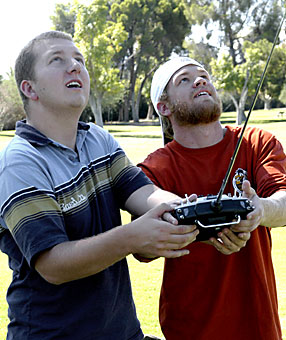 |
|
DAVID KEMPER/Arizona Daily Wildcat
|
Micro Air Vehicle club President Anton J. Kachevar and Treasurer Elliot Berg help each other control a model airplane at Himmel Park last week. The club builds and flies their own model planes.
|
|
|
By Kris Cabulong
Arizona Daily Wildcat
Thursday, October 21, 2004
Print this
A group of 20 UA students are working on an award-winning Micro-Air Vehicle design, which carries an onboard Global Positioning System, infrared sensors and cutting-edge artificial intelligence.
The students are part of the Micro Air Vehicle club, which hopes to develop a small, hard-to-detect unmanned aerial vehicle, or UAV, for use in military applications.
"The whole goal of the 12-inch autopilot plane is to be able to let the Army, specifically, use it," said Anton J. Kochevar president of the MAV club at the UA.
Kochevar, an aerospace and mechanical engineering senior, and the rest of the MAV team from the UA took first prize at the fourth annual Micro UAV Conference in Toulouse, France, last month.
"We won first prize for flying an MAV around a large triangular course," said Jeremy Tyler, aerospace engineering senior and vice president of the MAV club.
The prize-winning entry is little more than a red wing, a propeller and a box of electronics, but it can speed along between 45 and 50 mph. The team is trying to get the plane to fly 70 mph, Tyler said.
"We have to take-off the airplane and land the airplane right now," said Kochevar.
The club spends time researching for their vehicles, but members don't hesitate to admit they also spend a lot of time goofing around with radio-controlled planes, dog fighting each other in the skies.
"We're here to have fun, we're here to teach people how to build," Kochevar said.
All members learn how to construct and fly radio-controlled airplanes. Tyler, who teaches many of the new members to fly, has been flying for 20 years, the longest of any MAV club member. But mistakes still happen.
"I think I've hit A.J. (Kochevar) about a dozen times," said Tyler.
"And he's talking about me," Kochevar said. "Not my plane, but my actual person."
"It's always been accidental, but for some reason it always seems to be him," Tyler said.
The award-winning vehicle has been in the works for three years, Kochevar said.
The artificial intelligence built into the vehicle can maneuver it by autopilot to within 10 meters of up to 31 different targets before returning to its point of origin, where it will circle until someone manually takes control again, Kochevar said.
"The new autopilot we're looking to acquire will (allow) us to write a landing and take-off procedure, so we hope to have a fully autonomous airplane by the end of the semester," he said.
The MAV relies on an onboard GPS for navigation, which transmits information directly to the autopilot computer. Kochevar said there are no instruments to measure the aircraft's speed, direction or altitude.
Infrared sensors are the only means for the aircraft to orient itself to the ground. The sensors measure the heat from the ground to interpret which way is down.
Because of this, the MAV relies on pure navigation, from the GPS, and pure airplane stability, or balance, the latter of which is difficult for a 12-inch plane, said Kochevar.
"It's crude right now, but right now it's effective, and it's a lot cheaper," he said. "The (infrared) sensors cost 100 bucks, where the measurement instruments would cost $500 to $600."
But even with those savings, the costs still add up.
The prize-winning MAV's construction materials cost $25, Kochevar said. Electronics on the craft cost $200. The video recorder cost $500. This is the eighth model the team has designed.
"Unfortunately, it's a really expensive hobby," Kochevar said.
Eliot Berg, an aerospace and mechanical engineering senior, is the treasurer for the MAV club.
"We just ask a bunch of companies for money," he said.
Berg said funding for the club's research and travel expenses comes from sponsors of the Aerospace and Mechanical Engineering department, including Raytheon, Advanced Ceramics Research, Boeing, NASA and other companies.
But Kochevar said this year the MAV club isn't as well off.
"Raytheon was unable to supply us with any money this year," he said. Last year, Raytheon provided roughly $25,000 to MAV research.
Kochevar said contributions come in "because it's cutting-edge research."
"There's a lot that goes on in the lab," said Tyler.
In addition to work on the "fully autonomous airplane," other projects include the adaptive-wing UAV, which would allow the unmanned craft to change the shape of its wings during flight. The adaptive-wing is part of Tyler's senior design project.
Creighton Murrieta, senior in aerospace engineering, is working on an "ornithopter," which Murrieta describes as "mechanical flapping flight, modeled after hummingbirds and insects."
Murrieta, who is also a sergeant in the United States Marine Corps Reserve, said the biggest purpose for this kind of research is reconnaissance.
"It's stuff that companies see use in," Kochevar said. "If they see use in it they're going to sponsor us to try to do it."
Companies can't do everything, Kochevar said, and universities are funded by companies who can't do the research themselves.
Kochevar said students who are interested in the MAV club don't have to be aerospace or mechanical engineering majors to sign up, even though everyone in the club is either one or the other or both.
"One of the founders of the club was a communications major. Anybody can sign up," he said.
The MAV club meets at 6:30 p.m. in the Aerospace and Mechanical Engineering building in room N341.
